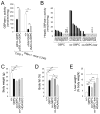Glycogen storage disease type Ia mice with less than 2% of normal hepatic glucose-6-phosphatase-α activity restored are at risk of developing hepatic tumors
- PMID: 28096054
- PMCID: PMC5346453
- DOI: 10.1016/j.ymgme.2017.01.003
Glycogen storage disease type Ia mice with less than 2% of normal hepatic glucose-6-phosphatase-α activity restored are at risk of developing hepatic tumors
Abstract
Glycogen storage disease type Ia (GSD-Ia), characterized by impaired glucose homeostasis and chronic risk of hepatocellular adenoma (HCA) and carcinoma (HCC), is caused by a deficiency in glucose-6-phosphatase-α (G6Pase-α or G6PC). We have previously shown that G6pc-/- mice receiving gene transfer mediated by rAAV-G6PC, a recombinant adeno-associated virus (rAAV) vector expressing G6Pase-α, and expressing 3-63% of normal hepatic G6Pase-α activity maintain glucose homeostasis and do not develop HCA/HCC. However, the threshold of hepatic G6Pase-α activity required to prevent tumor formation remained unknown. In this study, we constructed rAAV-co-G6PC, a rAAV vector expressing a codon-optimized (co) G6Pase-α and showed that rAAV-co-G6PC was more efficacious than rAAV-G6PC in directing hepatic G6Pase-α expression. Over an 88-week study, we showed that both rAAV-G6PC- and rAAV-co-G6PC-treated G6pc-/- mice expressing 3-33% of normal hepatic G6Pase-α activity (AAV mice) maintained glucose homeostasis, lacked HCA/HCC, and were protected against age-related obesity and insulin resistance. Of the eleven rAAV-G6PC/rAAV-co-G6PC-treated G6pc-/- mice harboring 0.9-2.4% of normal hepatic G6Pase-α activity (AAV-low mice), 3 expressing 0.9-1.3% of normal hepatic G6Pase-α activity developed HCA/HCC, while 8 did not (AAV-low-NT). Finally, we showed that the AAV-low-NT mice exhibited a phenotype indistinguishable from that of AAV mice expressing ≥3% of normal hepatic G6Pase-α activity. The results establish the threshold of hepatic G6Pase-α activity required to prevent HCA/HCC and show that GSD-Ia mice harboring <2% of normal hepatic G6Pase-α activity are at risk of tumor development.
Keywords: Gene therapy; Hepatocellular adenoma; Hepatocellular carcinoma; Recombinant adeno-associated virus vector.
Published by Elsevier Inc.
Conflict of interest statement
The authors have declared that no conflict of interest exists.
Figures




Similar articles
-
Gene therapy prevents hepatic tumor initiation in murine glycogen storage disease type Ia at the tumor-developing stage.J Inherit Metab Dis. 2019 May;42(3):459-469. doi: 10.1002/jimd.12056. Epub 2019 Mar 6. J Inherit Metab Dis. 2019. PMID: 30637773 Free PMC article.
-
Prevention of hepatocellular adenoma and correction of metabolic abnormalities in murine glycogen storage disease type Ia by gene therapy.Hepatology. 2012 Nov;56(5):1719-29. doi: 10.1002/hep.25717. Epub 2012 Aug 27. Hepatology. 2012. PMID: 22422504 Free PMC article.
-
Gene therapy using a novel G6PC-S298C variant enhances the long-term efficacy for treating glycogen storage disease type Ia.Biochem Biophys Res Commun. 2020 Jun 30;527(3):824-830. doi: 10.1016/j.bbrc.2020.04.124. Epub 2020 May 16. Biochem Biophys Res Commun. 2020. PMID: 32430177 Free PMC article.
-
Emerging roles of autophagy in hepatic tumorigenesis and therapeutic strategies in glycogen storage disease type Ia: A review.J Inherit Metab Dis. 2021 Jan;44(1):118-128. doi: 10.1002/jimd.12267. Epub 2020 Jul 2. J Inherit Metab Dis. 2021. PMID: 32474930 Review.
-
Type I glycogen storage diseases: disorders of the glucose-6-phosphatase/glucose-6-phosphate transporter complexes.J Inherit Metab Dis. 2015 May;38(3):511-9. doi: 10.1007/s10545-014-9772-x. Epub 2014 Oct 7. J Inherit Metab Dis. 2015. PMID: 25288127 Review.
Cited by
-
DBS Screening for Glycogen Storage Disease Type 1a: Detection of c.648G>T Mutation in G6PC by Combination of Modified Competitive Oligonucleotide Priming-PCR and Melting Curve Analysis.Int J Neonatal Screen. 2021 Nov 16;7(4):79. doi: 10.3390/ijns7040079. Int J Neonatal Screen. 2021. PMID: 34842616 Free PMC article.
-
Long-term safety and efficacy of AAV gene therapy in the canine model of glycogen storage disease type Ia.J Inherit Metab Dis. 2018 Nov;41(6):977-984. doi: 10.1007/s10545-018-0199-7. Epub 2018 May 25. J Inherit Metab Dis. 2018. PMID: 29802554
-
Preclinical Research in Glycogen Storage Diseases: A Comprehensive Review of Current Animal Models.Int J Mol Sci. 2020 Dec 17;21(24):9621. doi: 10.3390/ijms21249621. Int J Mol Sci. 2020. PMID: 33348688 Free PMC article. Review.
-
Liver-Directed Gene Therapy Mitigates Early Nephropathy in Murine Glycogen Storage Disease Type Ia.J Inherit Metab Dis. 2025 Jul;48(4):e70048. doi: 10.1002/jimd.70048. J Inherit Metab Dis. 2025. PMID: 40443300 Free PMC article.
-
Delivery of mRNA Therapeutics for the Treatment of Hepatic Diseases.Mol Ther. 2019 Apr 10;27(4):794-802. doi: 10.1016/j.ymthe.2018.12.012. Epub 2018 Dec 22. Mol Ther. 2019. PMID: 30655211 Free PMC article. Review.
References
-
- Chou JY, Matern D, Mansfield BC, Chen YT. Type I glycogen storage diseases: disorders of the glucose-6-phosphatase complex. Curr Mol Med. 2002;2:121–143. - PubMed
-
- Pan CJ, Lei KJ, Annabi B, Hemrika W, Chou JY. Transmembrane topology of glucose-6-phosphatase. J Biol Chem. 1998;273:6144–6148. - PubMed
-
- Greene HL, Slonim AE, O’Neill JA, Jr, Burr IM. Continuous nocturnal intragastric feeding for management of type 1 glycogen-storage disease. N Engl J Med. 1976;294:423–425. - PubMed
-
- Chen YT, Cornblath M, Sidbury JB. Cornstarch therapy in type I glycogen storage disease. N Engl J Med. 1984;310:171–175. - PubMed
Publication types
MeSH terms
Substances
Supplementary concepts
Grants and funding
LinkOut - more resources
Full Text Sources
Other Literature Sources
Medical
Molecular Biology Databases
Research Materials

